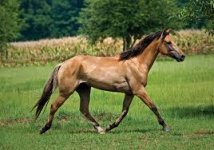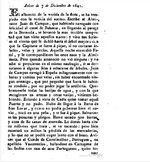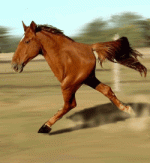Somewhat surprisingly, there is evidence the Spanish carried horses aboard treasure ships on the return trip to Spain.
Horseshoes and horse bones have been recovered from the Atocha site. There are references to the survivors of the 1715 fleet eating horses that swam and washed ashore after the storm.
Most people have heard of the wild horses of Assateague Island. There are conflicting theories as to their origin, but the idea the horses are descended from stock carried aboard the wrecked Spanish galleon La Galaga is not to be completely dismissed. The horses are almost certainly of Spanish origin-- however they first arrived.
I need not mention the vast amount of shipwreck treasure that has been found in the vicinity of Assateague Island.
I have a theory: if an isolated stock of feral horses with Spanish characteristics is found in an unusual coastal area---there is a chance those horses might be descended from horses that survived a Spanish shipwreck.
This would only be a clue, of course. Just a suggestive hint. It could never be proof.
There are wild horses on the Outer Banks of N.C....hmm...there are a few shipwrecks in that area, LOL.
Have you ever heard of the Carolina Marsh Tacky? Here is a picture:

They no longer exist in the wild and are a critically endangered breed, but they are almost certainly of Spanish origin.
They were discovered in substantial numbers by early English settlers as feral animals on Hilton Head Island, S.C.
As a matter of fact, there is still an annual Marsh Tacky race on the beaches of Hilton Head and/or Daufuskie Island, SC.
Could these animals, discovered by English settlers roaming freely on Hilton Head Island, be descended from shipwreck survivors?

"El alboroto de la venida de la flota, se ha templado con la noticia del suceso. Escribe el Almirante, Juan de Campos, que habiendo navegado con felicidad al canal de Bahama, en llegando al parage de la Bermuda, se levanto la mas terrible tempestad que han visto aquellos mares: y vino tan furioso el viento que le doblo hasta el arbol mayor; con que la Capitana se fuera a pique, si no cortaran arboles, velas y jarcias."
From Google Translate:
"bustle of the coming of the fleet, has been tempered by the news of the event. Write the Admiral, Juan de Campos, who, having sailed with happiness Bahama Channel, in arriving at the place of Bermuda, rose the most terrible storm they have seen those seas and the wind came so furious that I bow to the tree greater, with the Captain went under, if not cut trees, sails and rigging."
"en llegando al parage de la Bermuda" almost certainly means the fleet was struck by the storm as it reached the Latitude of Bermuda.
The Latitude of Bermuda? 32.3 degrees North...
The Latitude of Hilton Head Island, SC ? 32.21 degrees North...
Horseshoes and horse bones have been recovered from the Atocha site. There are references to the survivors of the 1715 fleet eating horses that swam and washed ashore after the storm.
Most people have heard of the wild horses of Assateague Island. There are conflicting theories as to their origin, but the idea the horses are descended from stock carried aboard the wrecked Spanish galleon La Galaga is not to be completely dismissed. The horses are almost certainly of Spanish origin-- however they first arrived.
I need not mention the vast amount of shipwreck treasure that has been found in the vicinity of Assateague Island.
I have a theory: if an isolated stock of feral horses with Spanish characteristics is found in an unusual coastal area---there is a chance those horses might be descended from horses that survived a Spanish shipwreck.
This would only be a clue, of course. Just a suggestive hint. It could never be proof.
There are wild horses on the Outer Banks of N.C....hmm...there are a few shipwrecks in that area, LOL.
Have you ever heard of the Carolina Marsh Tacky? Here is a picture:

They no longer exist in the wild and are a critically endangered breed, but they are almost certainly of Spanish origin.
They were discovered in substantial numbers by early English settlers as feral animals on Hilton Head Island, S.C.
As a matter of fact, there is still an annual Marsh Tacky race on the beaches of Hilton Head and/or Daufuskie Island, SC.
Could these animals, discovered by English settlers roaming freely on Hilton Head Island, be descended from shipwreck survivors?

"El alboroto de la venida de la flota, se ha templado con la noticia del suceso. Escribe el Almirante, Juan de Campos, que habiendo navegado con felicidad al canal de Bahama, en llegando al parage de la Bermuda, se levanto la mas terrible tempestad que han visto aquellos mares: y vino tan furioso el viento que le doblo hasta el arbol mayor; con que la Capitana se fuera a pique, si no cortaran arboles, velas y jarcias."
From Google Translate:
"bustle of the coming of the fleet, has been tempered by the news of the event. Write the Admiral, Juan de Campos, who, having sailed with happiness Bahama Channel, in arriving at the place of Bermuda, rose the most terrible storm they have seen those seas and the wind came so furious that I bow to the tree greater, with the Captain went under, if not cut trees, sails and rigging."
"en llegando al parage de la Bermuda" almost certainly means the fleet was struck by the storm as it reached the Latitude of Bermuda.
The Latitude of Bermuda? 32.3 degrees North...
The Latitude of Hilton Head Island, SC ? 32.21 degrees North...
Amazon Forum Fav 👍
Last edited:



